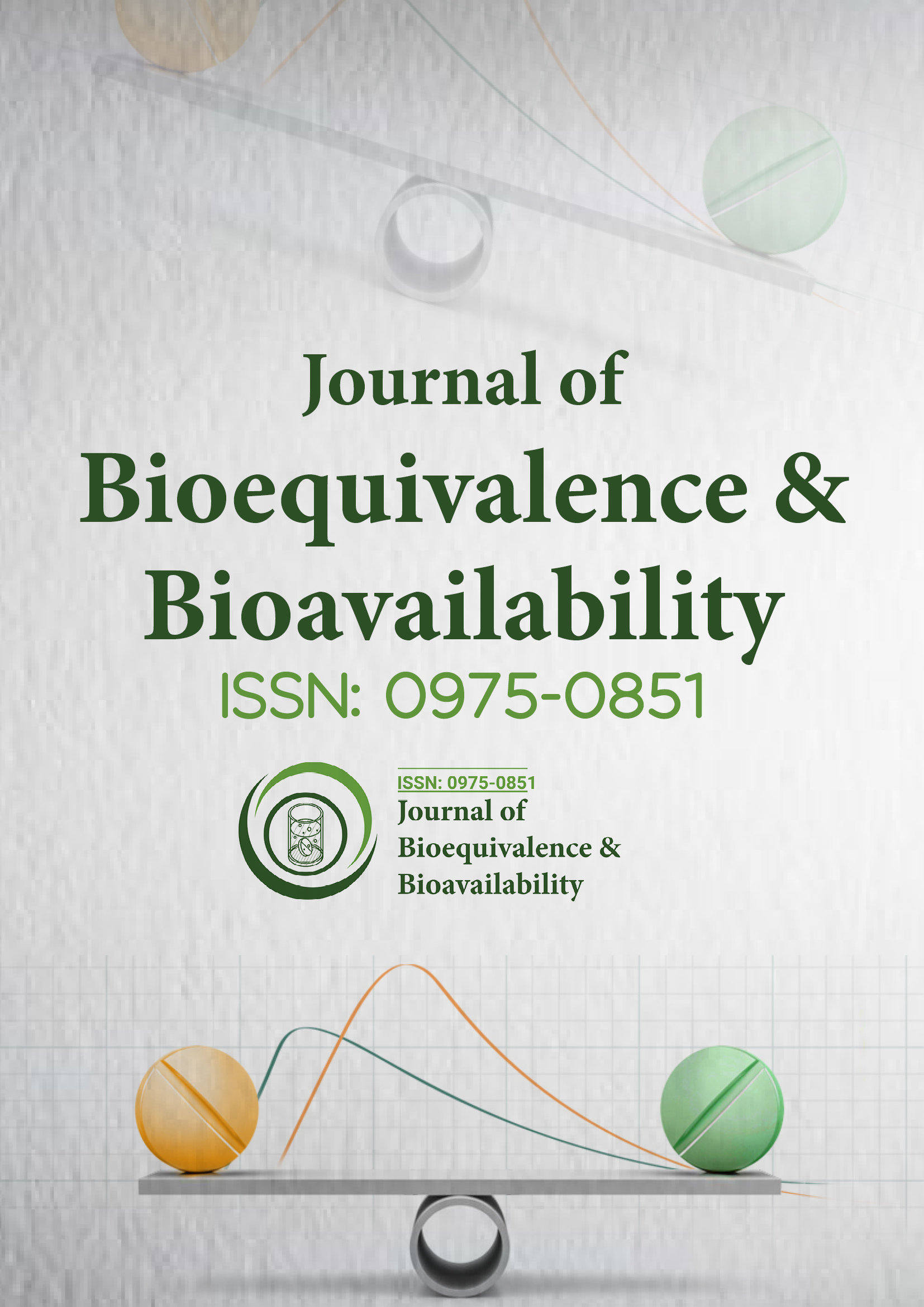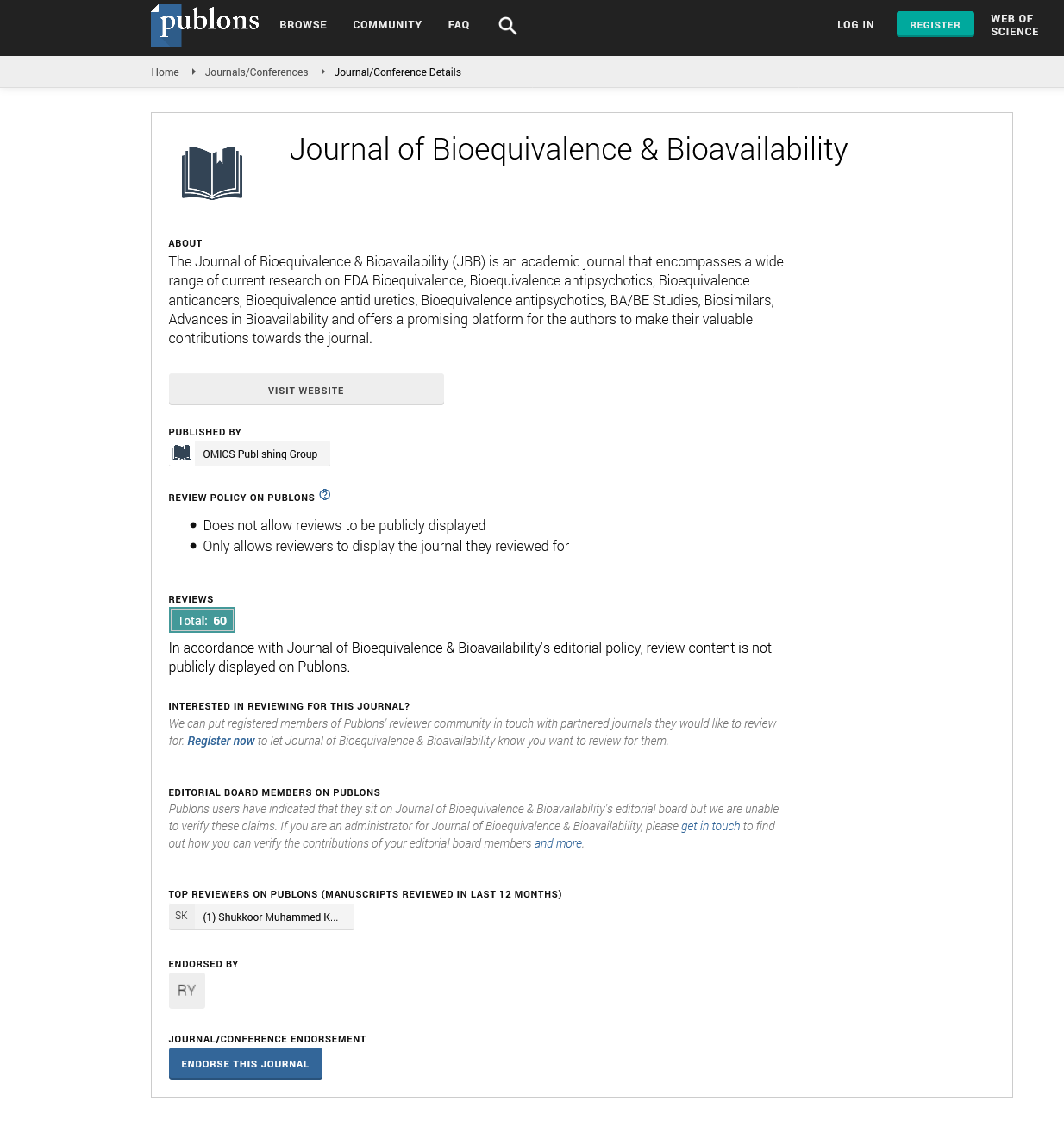Indexed In
- Academic Journals Database
- Open J Gate
- Genamics JournalSeek
- Academic Keys
- JournalTOCs
- China National Knowledge Infrastructure (CNKI)
- CiteFactor
- Scimago
- Ulrich's Periodicals Directory
- Electronic Journals Library
- RefSeek
- Hamdard University
- EBSCO A-Z
- OCLC- WorldCat
- SWB online catalog
- Virtual Library of Biology (vifabio)
- Publons
- MIAR
- University Grants Commission
- Geneva Foundation for Medical Education and Research
- Euro Pub
- Google Scholar
Useful Links
Share This Page
Journal Flyer

Open Access Journals
- Agri and Aquaculture
- Biochemistry
- Bioinformatics & Systems Biology
- Business & Management
- Chemistry
- Clinical Sciences
- Engineering
- Food & Nutrition
- General Science
- Genetics & Molecular Biology
- Immunology & Microbiology
- Medical Sciences
- Neuroscience & Psychology
- Nursing & Health Care
- Pharmaceutical Sciences
Opinion - (2025) Volume 17, Issue 1
Pharmacodynamic Variability and Its Implications for Generic Drug Approval
Emily Wilson*Received: 03-Feb-2025, Manuscript No. JBB-24- 28945; Editor assigned: 05-Feb-2025, Pre QC No. JBB-24- 28945 (PQ); Reviewed: 18-Feb-2025, QC No. JBB-24- 28945; Revised: 25-Feb-2025, Manuscript No. JBB-24- 28945 (R); Published: 04-Mar-2025, DOI: 10.35248/0975-0851.25.17.622
Description
Pharmacodynamic (PD) evaluation in Bioequivalence (BE) represents a critical, though often underutilized, dimension of generic drug assessment. Traditionally, the cornerstone of bioequivalence determination has been Pharmacokinetics (PK), especially metrics like maximum plasma concentration and Area Under the plasma concentration-time Curve (AUC). These markers serve as proxies for drug absorption and systemic availability. However, as pharmaceutical science continues to evolve and the market for complex generics expands, the limitations of relying solely on PK parameters have become increasingly apparent.
Even for systemically acting drugs, the inclusion of pharmacodynamic assessments can help clarify borderline cases where PK parameters fall close to the regulatory bioequivalence thresholds. In such cases, pharmacodynamic data can serve as a clinical safeguard, confirming whether the observed PK variations indeed affect therapeutic outcomes. This is particularly valuable for drugs like warfarin, lithium, digoxin or antiepileptics, where small deviations in blood levels can lead to either subtherapeutic exposure or adverse effects. By monitoring pharmacodynamic endpoints alongside PK data, regulators and healthcare providers can gain a more holistic understanding of how interchangeable two formulations truly are.
Some drugs exhibit delayed effects due to downstream biological mechanisms, receptor dynamics, or gene expression modulation. In these instances, simple time-matched PK-PD correlations may be insufficient. These tools enable the integration of temporal patterns of drug concentration and effect, enhancing our capacity to predict clinical performance from in vitro or early-phase data. However, these methods also demand advanced analytical capabilities and a deep understanding of pharmacological mechanisms, both of which may be lacking in many regulatory and industrial settings, particularly in resource-constrained environments.
From a regulatory perspective, agencies such as the U.S. Food and Drug Administration (FDA), European Medicines Agency (EMA), and Health Canada have provided frameworks for the use of pharmacodynamic endpoints in bioequivalence studies, particularly when PK assessments are not feasible. For example, the FDA's guidance on topical corticosteroids and inhalation products often recommends pharmacodynamic or clinical endpoint studies due to the localized nature of drug action. Similarly, ophthalmic products and gastrointestinal drugs have seen PD-based bioequivalence studies when systemic levels are undetectable or irrelevant. However, the acceptance of PD endpoints is still more the exception than the rule, and their use is typically reserved for niche or complex cases where traditional approaches are clearly inadequate.
Despite these hurdles, the future of bioequivalence testing is poised to be more inclusive of pharmacodynamic evaluation, driven by the proliferation of complex generics, personalized medicine, and advanced delivery systems. Biosimilars, for example, often require both pharmacokinetic and pharmacodynamic studies to demonstrate similarity to reference biologics, especially when immunogenicity and other biological responses are of concern. Likewise, combination products, nanomedicines, and targeted delivery platforms present unique challenges that cannot be adequately addressed through PK metrics alone. In these contexts, pharmacodynamic evaluation provides an indispensable lens through which therapeutic equivalence can be comprehensively assessed.
The integration of real-world data and patient-reported outcomes may also pave the way for broader acceptance of PD endpoints in bioequivalence. As electronic health records, wearable technologies, and digital biomarkers become more prevalent, the ability to monitor pharmacodynamic effects in naturalistic settings grows more feasible. These innovations offer the possibility of tracking therapeutic responses over extended periods and across diverse populations, thereby enriching the bioequivalence landscape with data that are both clinically relevant and reflective of actual use conditions. In this way, pharmacodynamic evaluation can evolve from being a niche or fallback approach to becoming a central pillar of evidence generation in the regulatory approval of generics.
In conclusion, pharmacodynamic evaluation in bioequivalence testing represents a nuanced but increasingly necessary component of modern pharmaceutical assessment. While traditional pharmacokinetic approaches remain valuable and often sufficient for many drugs, they fall short in capturing the full spectrum of therapeutic performance, especially for locally acting agents, complex delivery systems, and narrow therapeutic index drugs. Pharmacodynamic studies offer a complementary approach that grounds regulatory decisions in clinically meaningful outcomes, aligning more closely with how drugs are experienced by patients in real-world settings.
Citation: Wilson E (2025). Pharmacodynamic Variability and Its Implications for Generic Drug Approval. J Bioequiv Availab. 17:622.
Copyright: © 2025 Wilson E. This is an open-access article distributed under the terms of the Creative Commons Attribution License, which permits unrestricted use, distribution, and reproduction in any medium, provided the original author and source are credited.

